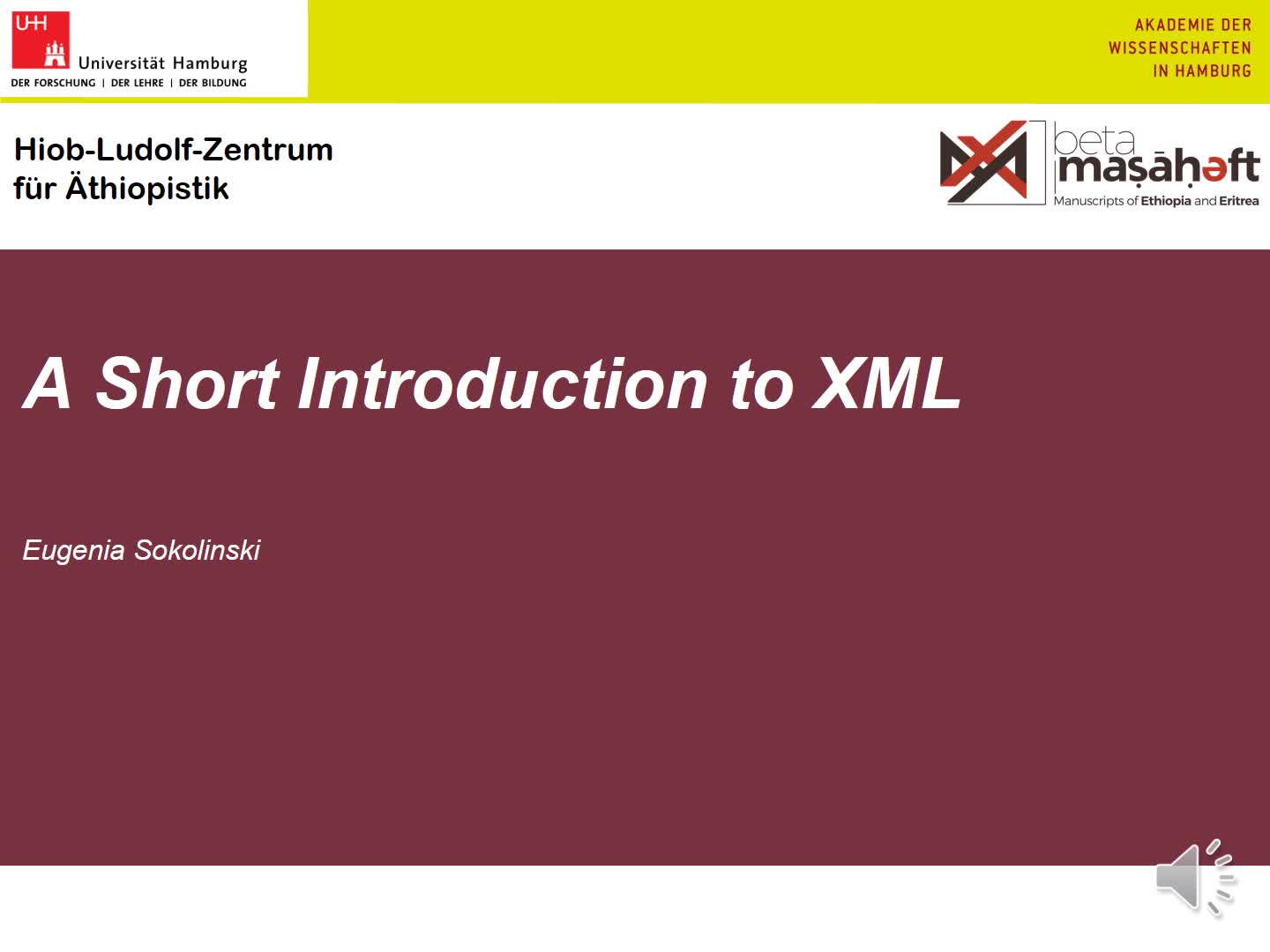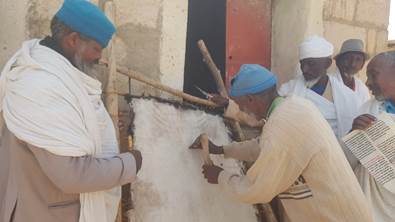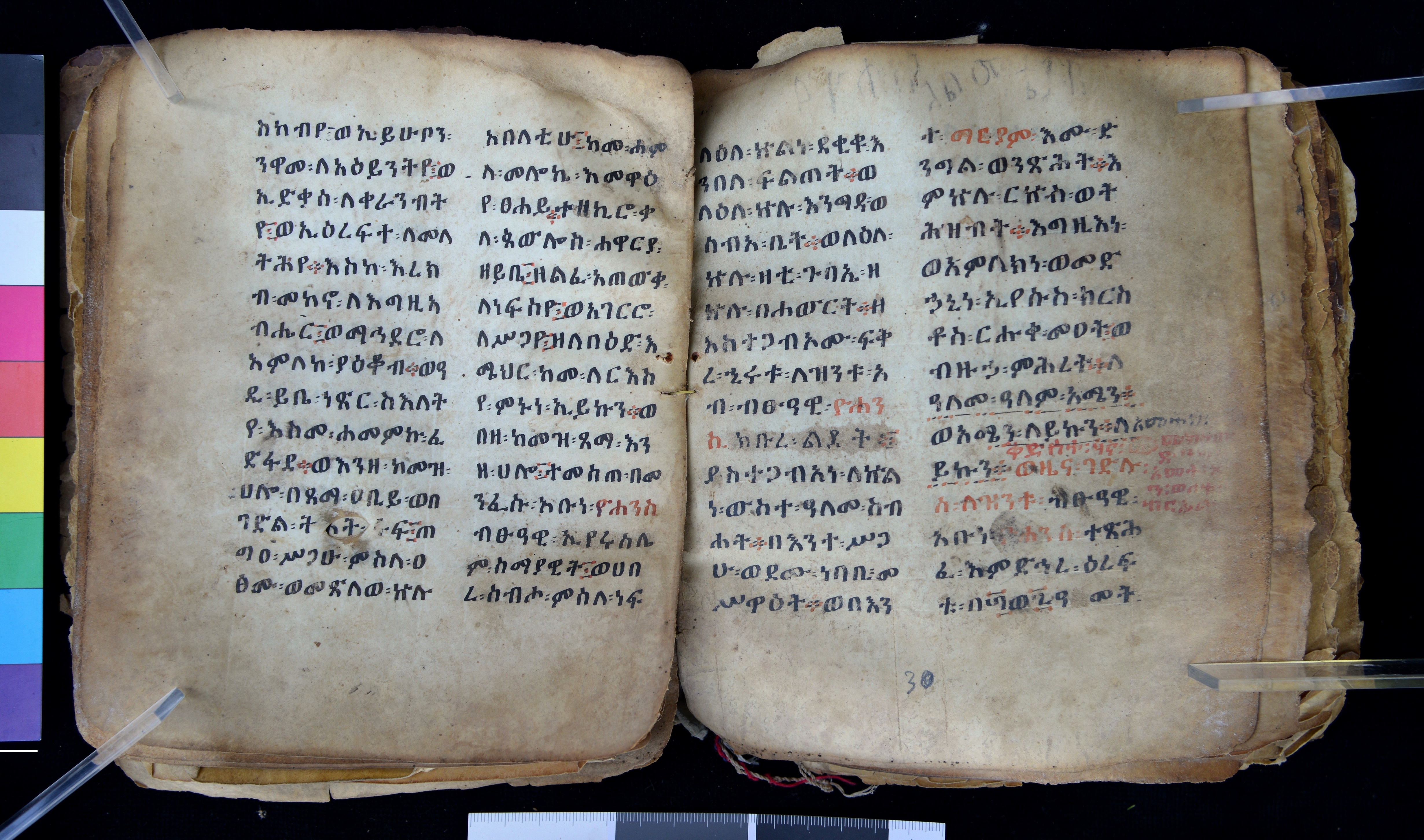May 2024 highlight: Beta maṣāḥǝft Guidelines

Beta maṣāḥǝft is a collaborative platform that welcomes everyone to use the data and to contribute the data. Elaborate guidance, from setting up the software to the workflow to specific examples of encoding are provided in the Beta maṣāḥǝft Guidelines application.
Besides providing assistance in the encoding process, the application also features a Transliteration Tool, supporting conversion between Ethiopic and Latin script.
Users can also find an archive of project training materials, with presentations and lectures (or links to lectures and presentations) prepared for various occasions
April 2024 highlight: Encoded catalogues

Beta maṣāḥǝft has been gradually producing a searchable digital version of historical catalogues. Thereby the descriptions have been not only digitally encoded according to the project XML schema, but also translated into English wherever necessary, and updated with new data coming from recent publications and/or consultation of actual manuscripts or their digital surrogates.
The constantly growing list of catalogues used by the project can be consulted at https://betamasaheft.eu/catalogues/list. Choosing a catalogue from the list users can obtain a filtered list of all manuscripts from the catalogue now available on the Bm application.
March 2024 highlight: Ethiopic manuscripts of St Catherine’s Monastery on Mount Sinai
Six Ethiopic manuscripts preserved in St Catherine are already well known to the scholarly community (Sinai Ethiopic 001-006), having been microfilmed by Library of Congress in cooperation with the American Foundation for the Study of Man and Farouk I University (1950) and catalogued by the Egyptian Ethiopianist Murad Kamil (1957). The collection has been recently expanded by one more manuscript (Sinai Ethiopic 007) which is a private gift. Following the collapse of a tower and the ensuing restauration work, further manuscripts and fragments were discovered in the monastery in 1975. Ethiopic manuscripts had been mentioned summarily as being among them, but have been neither described nor studied yet.
In 2023, Denis Nosnitsin and Dorothea Reule of the Bm project had the possibility to survey the manuscripts and produce a description of the entire Ethiopic collection. The description (and partially the images) of 15 manuscripts can now be accessed at https://betamasaheft.eu/
For a detailed report visit https://www.betamasaheft.uni-hamburg.de/manuscripts/newresearch/stcatherine.html
February 2024 highlight: Beta maṣāḥǝft working papers

New research conducted within the Beta maṣāḥǝft project is reflected in the Working Papers series of open access publications. As of January 2024, four issues have appeared:
- Nosnitsin, D. 2023. After Ethio-SPaRe: Beta maṣāḥǝft Field Research 2016-2019. Part 1: Further churches of Tigray and their manuscript collections , Beta maṣāḥǝft working papers, 1 (Hamburg: Universität Hamburg, 2023), 1–70. DOI 10.25592/uhhfdm.13984
- Nosnitsin, D., Amanuel Abrha, and Hagos Gebremariam 2023. After Ethio-SPaRe: Beta maṣāḥǝft Field Research 2018-2019. Part 2: Lǝggat Qirqos and its Bookmaking , Beta maṣāḥǝft working papers, 2 (Hamburg: Universität Hamburg, 2023), 1–46. DOI 10.25592/uhhfdm.13988
- Guesh Solomon 2023. Manuscript inventorying and digitization filed survey in Central Tigray: Guyā Takla Ḥāymānot and ʾAmbǝrsǝwā Mikāʾel (Qollā Tamben) , Beta maṣāḥǝft working papers, 3 (Hamburg: Universität Hamburg, 2023), 1–8. DOI 10.25592/uhhfdm.13989
- Nosnitsin, D. 2024. Ethiopic Hagiography: History, Saints and Texts , Beta maṣāḥǝft working papers, 4 (Hamburg: Universität Hamburg, 2024), 1–17. DOI 10.25592/uhhfdm.14069
January 2024 highlight: New data on the hagiographic tradition of Yoḥannes of Wifāt
In the course of the latest field research (November 2023) it was possible to collect more data on one of the lesser known hagiographic traditions of Ethiopia, that of Yoḥannes of Wifāt. Yoḥannəs of Wifāt was a monastic leader who died in 1443/44. The founder of the monastery of (Dabra) Wifāt, he was a monk from the southern or central Ethiopia. As a a few other monasteries, Dabra Wifāt might have been prominent up to the 16th century, but disappeared due to the 16th-century Muslim wars and population movement. However, the veneration of Yoḥannəs of Wifāt continued in northern Ethiopia, similar to the cases of some other saints, such as for instance Takla Hāymānot and Gabra Manfas Qəddus.
The first literary witness of the tradition was discovered during a field mission of the project Ethio-SpaRe as early as 2012, in the library of the monastery Rubākusa Giyorgis in Tamben. It was a manuscript from the 18th century. Now, a second, much earlier witness, possibly from as early as the 16th century, could be photographed in a small church of Qanaf Gabriʾel located in waradā ʾĀdet (Central Tigray).
It is not the first and hopefully not the last time that the field research by the Bm project has pushed further the limits of our knowledge of Ethiopic literature and Ethiopian cultural patrimony, and yields more interesting Ethiopic works to study.
December 2023 highlight: Organizing field work in a conflict area
The core of the project Beta maṣāḥǝft: Manuscripts of Ethiopia and Eritrea (Schriftkultur des christlichen Äthiopiens und Eritreas: eine multimediale Forschungsumgebung) is a systematic overview of the rich manuscript heritage. The team encodes both the descriptions of known manuscripts from published catalogues and produces new descriptions for previously unknown and/or uncatalogued manuscripts. For this latter task, reliable cooperation with local institutions in Ethiopia and Eritrea and regular field and digitization missions to the research area are of primary importance. Among the areas of primary importance is the historical core of the Ethiopian-Eritrean civilization, now divided between the northern Ethiopia (the province of Tigray, where the ancient capital of Aksum is located) and southern Eritrea (Zoba Debub). The long-lasting tensions between the two states have so far rendered impossible active research on the Eritrean side of the border, yet fruitful cooperation had been possible for many years with the authorities of Tigray.
The outbreak of an armed conflict between the Federal Government of Ethiopia and the regional Government of Tigray in November 2020 collapsed many hopes of research projects and cooperation between western and local educational institutions. In the course of the war, the universities in Tigray region were severely affected and the universities’ staff was struggling for physical survival. This was happening not only during the time of the open warfare but even more so during the so-called “Siege of Tigray” (ca. July 2021–the fall of 2022). In that time, neither research no educational activities appeared to be possible; universities and institutions in charge of the cultural heritage were closed, and salaries were not paid. Significant physical damage was caused both to academic institutions and to cultural heritage sites. The partners of the project Beta maṣāḥǝft now found themselves in an extremely difficult situation.
Extensive field research in the region which had been long planned in cooperation with the local partners to document the valuable manuscript heritage preserved in the churches and monasteries in Tigray, had already been put on hold during the coronavirus pandemic. Due to the military actions and the siege of Tigray, the travel warning of the Foreign Ministry of Germany was issued, making any travel into the region impossible.
Not discouraged by the appalling situation, the project found ways to achieve its goals by reorganizing its field missions and delegating tasks to local partners. Among other measures, the cooperation with the staff of Adigrat University has been promoted; a recent report has been published at https://www.betamasaheft.uni-hamburg.de/about/situation/fieldwork.html.
November 2023 highlight: Fall School Manuscript Studies
Political situation and changes in German foreign policy prevented several students from Ethiopia and Russia from attending the Summer School Working in Manuscript Studies: Traditional and New Approaches, with a focus on the Ethiopian and Eritrean tradition in Hamburg last September.
It has been therefore decided by the Beta maṣāḥǝft project team to organize an additional Fall School Working in Manuscript Studies in Addis Ababa, Ethiopia, from 20 to 24 November 2023, cofinanced by the Academy of Sciences and Humanities in Hamburg and the Gerda Henkel Stiftung through its Hamburg-based project Documenting an Ancient Education System in Africa: ʾAbǝnnat Tǝmhǝrt in Ethiopia.
Thanks to the efforts of the project team, 30 more students from Ethiopia (Addis Ababa, Gondar, Bahir Dar, Wolkite, Addigrat, Aksum) and Russia were able to profit from the unique expertise and also have the rare opportunity to get a hands-on experience in cataloguing, text work, and digitization this year.
A visit to the Urban Scriptorium, where students were able to get a first-hand experience in traditional manuscript production, from parchment to text to illustration, was a highlight of the Fall School.
October 2023 highlight: Bm Workflow and Crowdsourcing for Research
In October 2023, the Bm project featured its workflow in a poster at the Digital Total event, organized and conducted by the House of Computing and Data Science (HCDS) of the Universität Hamburg, in collaboration with partners from the scientific platform PIER PLUS and the Academy of Sciences and Humanities in Hamburg.
The poster focuses on the crowdsourcing for research, pioneered for Ethiopian and Eritrean manuscript studies by the Bm project.
September 2023 highlight: Summer School Working in Manuscript Studies
From 4 to 15 September 2023, the Beta maṣāḥǝft organized, in cooperation with the Academy projects Etymologika. Ordnung und Interpretation des Wissens in griechisch-byzantinischen Lexika bis in die Renaissance. Digitale Erschliessung von Manuskriptproduktion, Nutzerkreisen und kulturellem Umfeld and Formulae-Litterae-Chartae organized its seventh Summer School Working in Manuscript Studies: Traditional and New Approaches, with a focus on the Ethiopian and Eritrean tradition Thanks to the generous support of the VolkswagenStiftung, the Academy of Sciences and Humanities in Hamburg, and the Centre for the Study of Manuscript Cultures 25 students from Ethiopia, Germany, Italy, France, China, Turkey, USA, Poland, and Russia were able to profit from the unique expertise and also have the rare opportunity to get a hands-on experience in cataloguing, digitization, and using advanced digital humanities tools and approaches.
August 2024 highlight: Biblioteca Medicea Laurenziana
Thanks to the cooperation with the Biblioteca Medicea Laurenziana and to the financial support from the Hamburg-based Sonderforschungsbereich 950 ' Manuskriptkulturen in Asien, Afrika und Europa' and the ERC project 'TraCES, From Translation to Creation: Changes in Ethiopic Style and Lexicon from Late Antiquity to the Middle Ages', in 2018 the Beta maṣāḥǝft could co-organize a mission to Florence, where the Ethiopic collection of the Biblioteca Medicea Laurenziana could be digitized (by Antonella Brita, Karsten Helmholz and Susanne Hummel).
In 2019 the images, alongside XML metadata stubs, were made available on the Bm website. They were subsequently aligned with automatic transcription acquired with the help of the Transkribus software, where a model had been specifically trained for Ethiopic by Pietro Liuzzo. The transcriptions (partially manually corrected) were also made available on the Bm platform.
In 2023, Carsten Hoffmann carried out the cataloguing of the manuscripts, using the published catalogues by Paolo Marrassini as well as the digitally available images. The collection can now be consulted at https://tinyurl.com/BMLethiopic
July 2023 highlight: Bm project presentations
Project members regularly showcase the project and offer trainings in creating and accessing project data.
Take a look at this recent presentation offering a quick overview
Visit our Training materials section for even more presentations.



